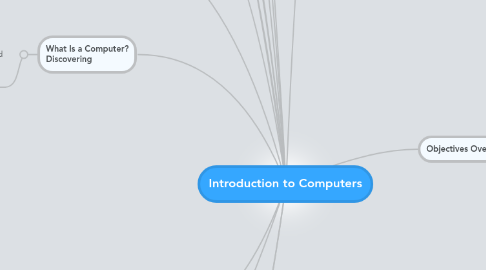Introduction to Computers
by Gomphrena Partiezza

1. The components of a computer
1.1. Input Device • Allows you to enter data and instructions into a computer
1.2. Output Device • Hardware component that conveys information to one or more people
1.3. System Unit • case that contains the electronic components of the computer that are used to process data
1.4. Storage Device • Holds data, instructions, and information for future use
1.5. Communications Device • Enables a computer to send and receive data, instructions, and information and from one or more computer or mobile devices
1.6. New node
2. What Is a Computer? Discovering
2.1. A computer is an electronic device, operating under the control of instructions stored in its own memory
3. Advantages and Disadvantages of Using Computers
3.1. Advantages of Using Computers
3.1.1. Speed
3.1.2. Reliability
3.1.3. Consistency
3.1.4. Storage
3.1.5. Communications
3.2. Disadvantages of Using Computers
3.2.1. Health Risks
3.2.2. Violation of Privacy
3.2.3. Public Safety
3.2.4. Impact on Labor Force
3.2.5. Impact on Environment
4. Networks and the Internet
4.1. A network is a collection of computers and devices connected together, often wirelessly, via communications devices and transmission media
4.2. The Internet is a worldwide collection of networks that connects millions of businesses, government agencies, educational institutions, and individuals
4.3. A social networking Web site encourages members to share their interests, ideas, stories, photos, music, and videos with other registered users
5. Computer Software
5.1. Software, also called a program, tells the computer what tasks to perform and how to perform them
5.2. Installing is the process of setting up software to work with the computer, printer, and other hardware
5.3. New node
6. Personal Computers can perform all of its input, processing, output, and storage activities by itself • Two popular architectures are the PC and the Apple – Desktop computer
7. Game Consoles
8. Servers
9. Mainframes
10. Supercomputers
11. Embedded Computers is a special‐purpose computer that functions as a component in a larger product
12. Elements of an Information System
12.1. Hardware
12.2. Software
12.3. Data
12.4. People
12.5. Procedures
13. Examples of Computer Usage
13.1. Home User
13.2. Small Office/Home Office User
13.3. Mobile User
13.4. Power User
13.5. Enterprise User
14. Computer Applications in Society
14.1. Education
14.2. Finance
14.3. Government
14.4. Health Care
14.5. Science
14.6. Publishing
14.7. Travel
14.8. Manufacturing
15. Objectives Overview
15.1. Distinguish between system software and application software
15.2. Differentiate among types, sizes, and functions of computers in each category
15.3. Describe the role of each element in an information system
15.4. Explain how home users, small office/home office users, mobile users, power users, and enterprise users
15.5. Discuss how society uses computers in education, finance, government, health care science publishing computers care, science, publishing, travel, and manufacturing
15.6. Define the term, Explain why computer literacy is vital to success in today’s world
15.7. Define the term, computer, and describe the relationship between data and information
15.8. Describe the five components of a computer
15.9. Discuss the advantages and disadvantages that users experience when working with computers
15.10. Define the term, network, and identify benefits of sharing resources on a network
15.11. Discuss the uses of the Internet and World Wide Web
16. Mobile Computers and Mobile Devices
16.1. Notebook computer Tablet PC Smart phone PDA Handheld computer Portable media player Digital camera Click to view Web Link,


